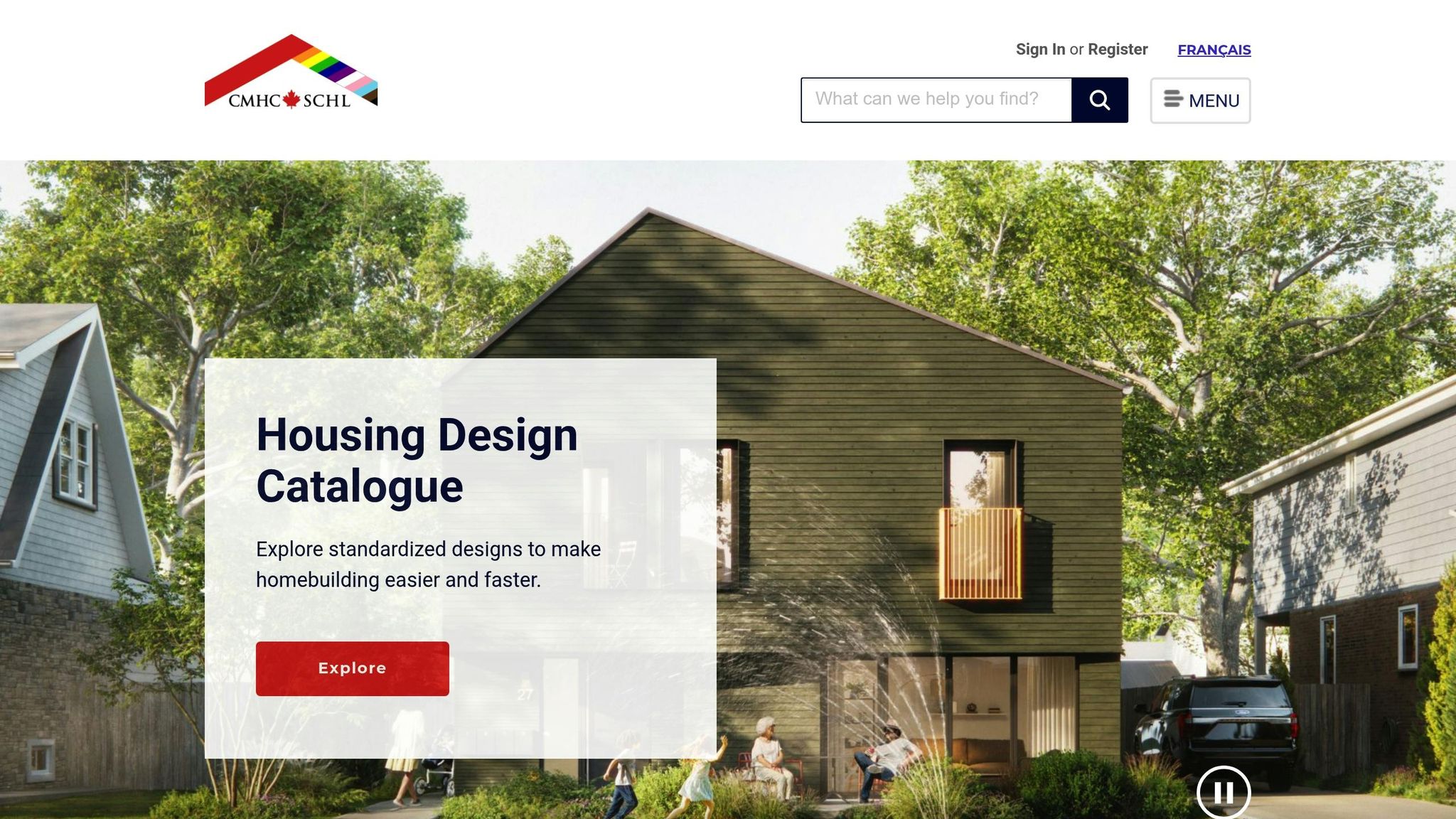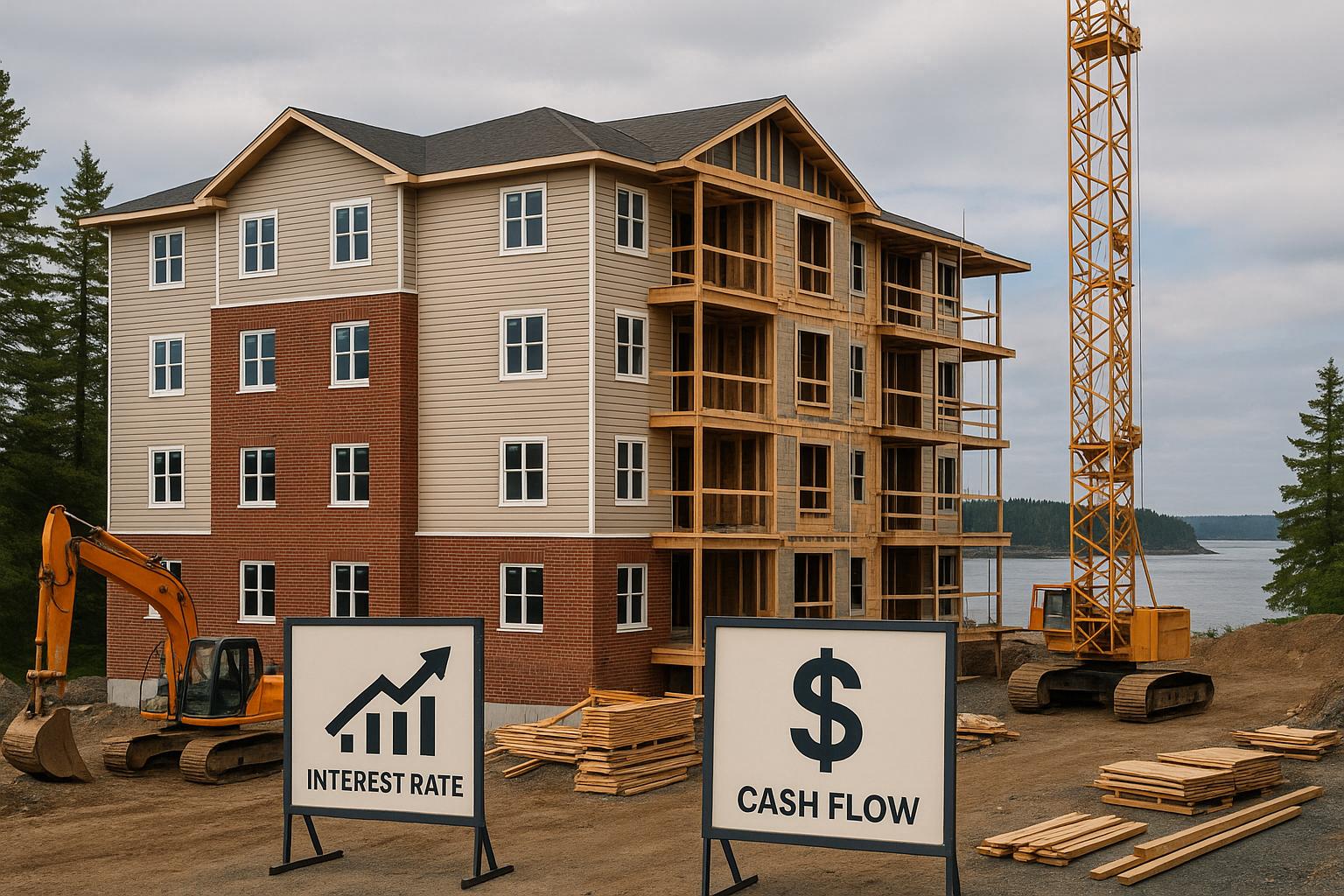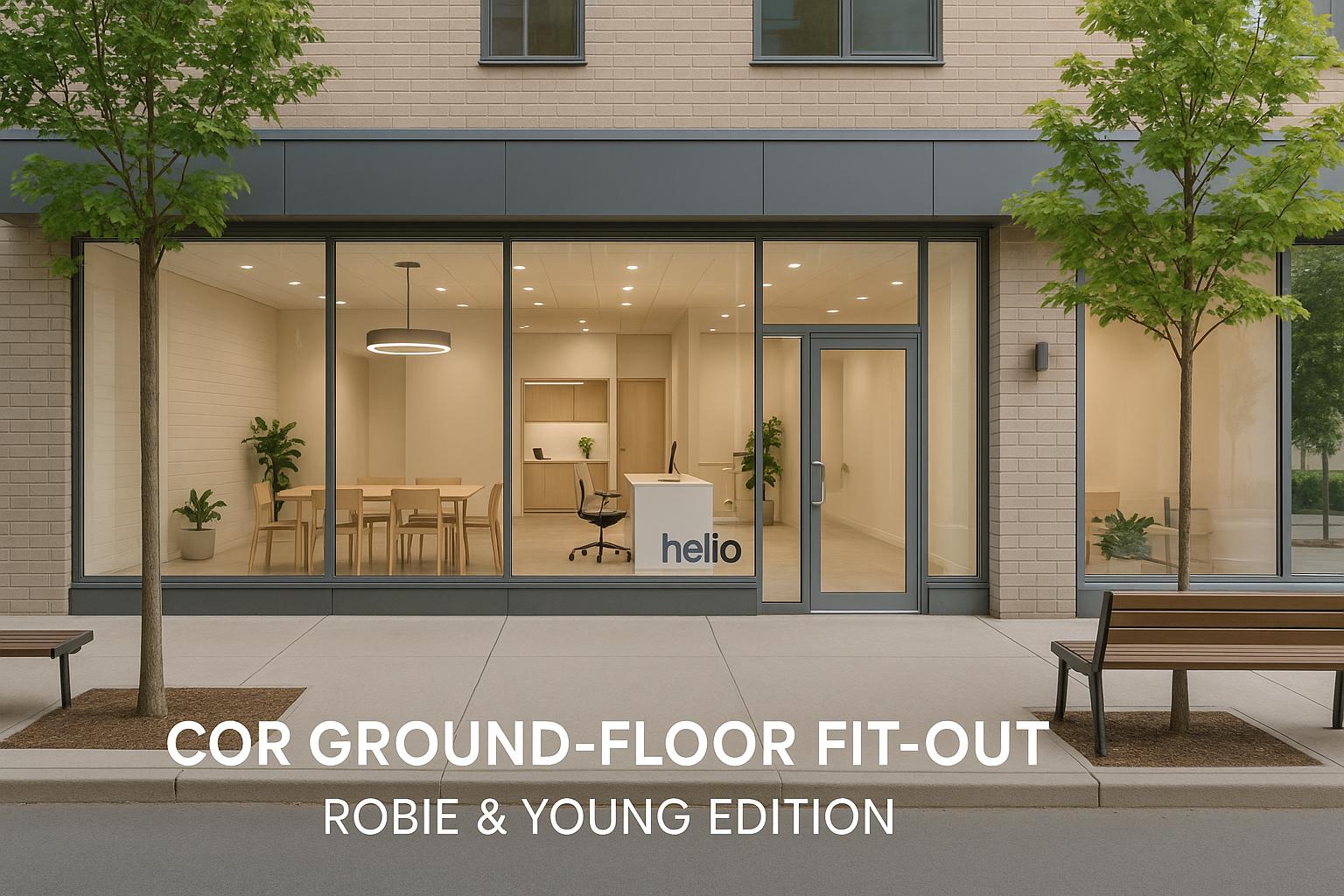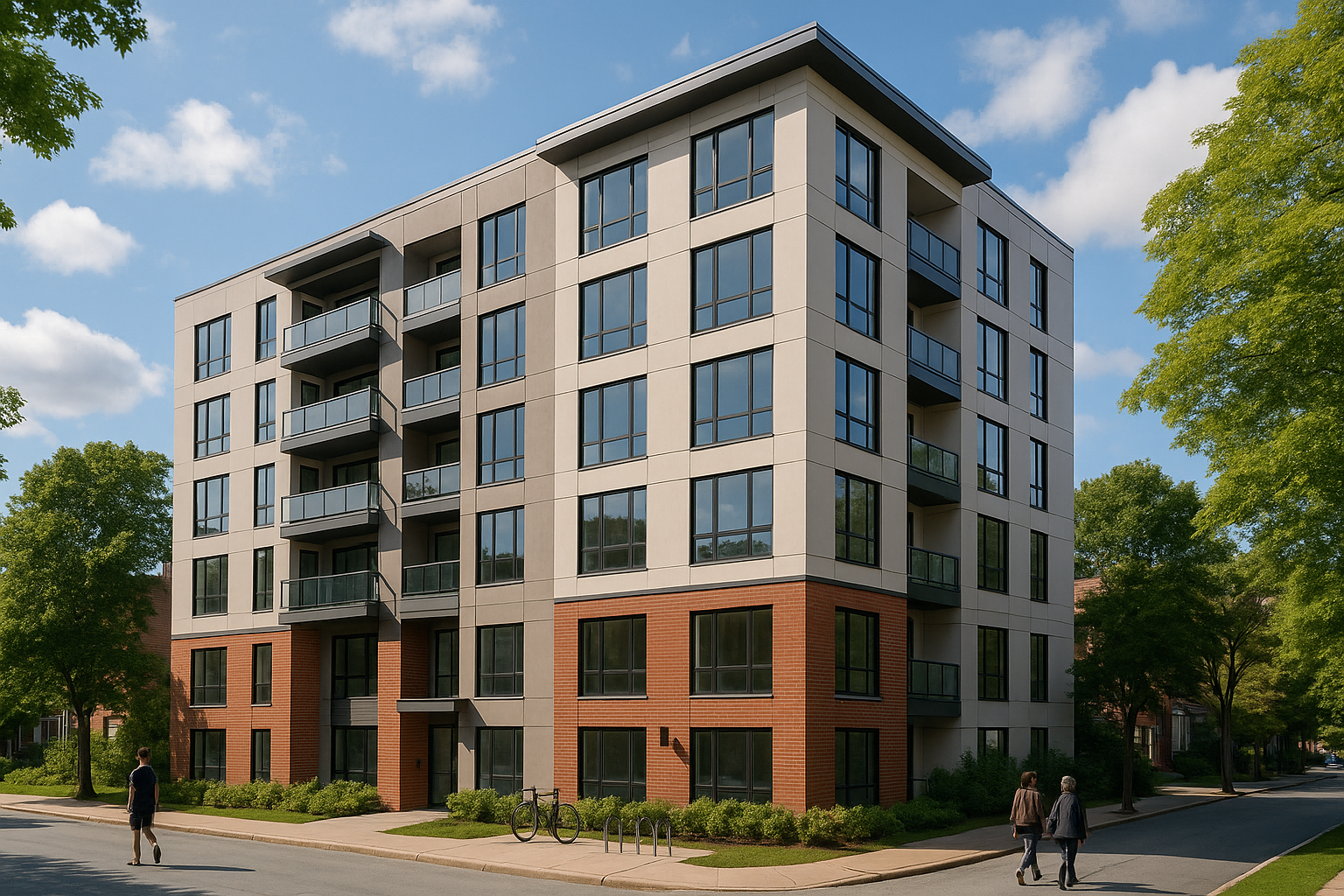ER-3 zoning in Nova Scotia is tailored for medium-density residential projects, typically ranging from 4 to 24 rental units. Construction costs per unit for these developments range between $160,000 and $200,000, depending on design and energy efficiency standards. Standard builds cost around $160,000/unit, while energy-efficient builds are priced at $200,000/unit but offer better financing options through CMHC MLI Select, including 95% financing and 50-year amortization.
Key cost factors include:
- Zoning regulations: Height, density, parking, and setbacks.
- Material and labour costs: High in Nova Scotia due to shortages.
- Construction methods: Integrated design-build is more efficient and cost-stable than fragmented approaches.
Challenges like rezoning delays and building code requirements can increase costs. Fixed pricing and integrated construction methods help control budgets and timelines, offering property owners more predictability and fewer risks.
Cost Per Unit Benchmarks
Current Cost Per Unit Ranges
In Nova Scotia, the cost of building ER-3 rental units currently falls between $160,000 and $200,000 per unit, depending on the construction package and energy efficiency standards selected. These figures represent the actual costs paid to builders for fully completed rental units.
For standard construction, you should plan for approximately $160,000 per unit. This pricing applies to projects with at least four units, meaning the total construction cost starts at $640,000. This includes key features such as ductless heat pumps, triple-pane windows, quartz countertops, engineered hardwood flooring, and custom millwork.
If you’re looking at energy-efficient builds, the cost rises to $200,000 per unit, with a minimum project cost of $800,000 for four units. These builds are designed to exceed standard building codes, offering 40% greater energy efficiency, and often qualify for special financing programs.
The higher price for energy-efficient construction reflects the extra materials, labour, and engineering required. However, property owners often see benefits through lower tenant utility costs and better financing options. Up next, we’ll explore how these costs compare to CMHC MLI Select builds.
Standard vs. CMHC MLI Select Builds

Deciding between standard construction and CMHC MLI Select builds can significantly affect both upfront costs and long-term financing. Standard builds, priced at $160,000 per unit, focus on providing a solid return on investment with quality finishes that attract tenants paying monthly rents between $1,950 and $2,100.
On the other hand, CMHC MLI Select builds, priced at $200,000 per unit, come with a different set of advantages. These builds qualify for the CMHC Multi-Unit Residential Loan Insurance program, offering 95% financing with just a 5% down payment.
The financing benefits are substantial. Standard builds require a 20% down payment, giving you a 5:1 leverage, while CMHC MLI Select builds allow 20:1 leverage with only 5% down. Additionally, these projects qualify for 50-year amortization periods, reducing monthly mortgage payments despite the higher construction cost.
For many property owners, the improved financing terms make CMHC MLI Select builds cash flow positive from the start, even with the higher per-unit price. Ultimately, the choice depends on whether you aim to maximize immediate returns or leverage superior financing to grow your portfolio more quickly. A fixed-price, integrated approach often helps minimize risks in either case.
What's Included and What's Not
Breaking down the per-unit cost helps clarify what’s covered in your budget. The $160,000 to $200,000 per unit pricing generally includes the following:
- Structural work
- Electrical and plumbing systems
- HVAC installation
- Interior finishes
- Exterior cladding and roofing
- Fixtures
- Engineering inspections and quality control
- Warranty coverage
However, land acquisition costs are not included, as property owners are expected to already own the land. Site preparation, such as excavation, foundation work, and utility connections, may be priced separately depending on lot conditions and municipal requirements.
Other excluded costs typically involve development fees, legal expenses, and construction financing interest during the build. Some builders also exclude optional add-ons like appliance packages, window coverings, and smart home technology. For instance, adding a complete appliance and technology package could cost an extra $15,000 per unit but may save money through bulk purchasing and allow for immediate tenant occupancy.
It’s also wise to budget for a contingency allowance beyond the quoted per-unit price. Unexpected site conditions or design changes during construction can lead to additional costs, even with fixed-price contracts. Having a contingency plan helps property owners manage risks effectively and avoid unwelcome surprises.
Building A New Multi-Family Building In Canada - The Ups, Downs and Costs of Construction - Part 1
What Drives ER-3 Construction Costs
When planning a multi-unit rental project, getting a handle on what influences construction costs is key. Among the most influential factors are design choices and unit features. Later, we’ll discuss other cost drivers like site conditions, labour, and material expenses.
Design Choices and Unit Features
The materials you select, the finishes you choose, the size of the units, and the complexity of the layout all have a direct impact on the budget. For example, larger or uniquely shaped units require more materials and labour, which naturally drives up costs compared to simpler, rectangular layouts. Similarly, going above and beyond building code requirements with advanced energy-efficient upgrades can significantly increase expenses. Striking the right balance between design elements and budget priorities is essential for achieving quality construction without overspending.
sbb-itb-16b8a48
Construction Methods: Fragmented vs. Integrated
How you approach construction can drastically affect the budget and timeline of your ER-3 project. In Nova Scotia, many property owners lean towards a fragmented approach, where different contractors handle various aspects of the job. However, an integrated approach can simplify the process and lead to substantial savings.
Multiple Contractors vs. Single Builder
A fragmented construction method usually involves hiring six or more professionals, including architects, engineers, general contractors, electricians, plumbers, and other specialists. Each operates independently, with their own contracts, schedules, and pricing.
This setup often creates significant coordination headaches. You’re left juggling schedules, resolving disputes between trades, and managing a pile of invoices. When delays or issues arise - and they always do - you’re stuck mediating between contractors, each pointing fingers at the others for cost overruns or schedule setbacks.
An integrated design-build approach flips this model. Instead of managing multiple contractors, you work with a single company that handles everything from initial planning to final construction. Architects, engineers, and construction crews collaborate under one roof, avoiding the communication breakdowns that plague fragmented projects. This integrated method directly addresses the delays and budget overruns that are common with traditional builds.
Common Problems with Multiple Contractors
Budget overruns are almost inevitable with the fragmented approach. On average, property owners experience cost increases of 30-60% beyond their original estimates. Why? No single contractor takes responsibility for the overall project cost, leading to unexpected change orders as new issues emerge.
Timelines often spiral out of control too. Projects that should take 8 months can drag on for 18 months or more, adding to expenses like extended construction loans and delaying rental income.
Transparency is another major issue. You’re often left in the dark, piecing together conflicting updates from different contractors and unsure about what’s actually happening on-site.
How Integrated Design-Build Works
The integrated design-build approach offers a far more streamlined alternative. Companies like Helio Urban Development showcase how this method resolves the inefficiencies of fragmented construction. By combining planners, architects, engineers, and construction teams into a single company, they eliminate the coordination problems that typically cost property owners an average of $47,000 per project.
With this approach, you get fixed-price construction - $160,000 per unit - with a guaranteed 6-month timeline. If the project runs late, penalties of up to $1,000 per day kick in, ensuring accountability.
You also benefit from daily photo updates, so you can track progress without constant site visits. Quality control is handled through systematic inspections, rather than relying on individual contractors to meet standards. If problems arise, there’s no finger-pointing - one company takes full responsibility for resolving issues.
Scheduling is another standout advantage. Integrated teams coordinate tasks to avoid delays, with advanced systems preventing bottlenecks. Unlike fragmented builds, where one trade has to finish before another can begin, integrated methods allow for overlapping schedules, saving months of construction time.
This approach turns construction into a predictable, efficient process. It gives you the budget certainty and timeline reliability needed to make your rental property project a success.
How to Protect Your Budget and Timeline
Ensuring the success of an ER-3 project comes down to safeguarding your budget and timeline. While traditional construction often leaves property owners grappling with unexpected costs and delays, the integrated design-build approach offers a way to secure both from the outset. Here's how fixed pricing and strict timeline management can protect your investment.
Fixed Prices and Guaranteed Timelines
The design-build model is built around fixed pricing and clear timelines. With fixed-price construction, you eliminate the uncertainty of fluctuating costs. Instead of worrying about budget overruns, you lock in a set price before construction begins. For instance, Helio Urban Development provides fixed-price construction at $160,000 per unit. Any unexpected cost changes are absorbed by the builder, ensuring you stay on budget.
Timelines are just as secure. Instead of vague promises, you get a concrete schedule. Helio guarantees a 6-month construction timeline, with financial penalties of up to $1,000 per day for delays. This commitment minimizes potential setbacks that could disrupt your rental income, giving you the confidence to plan your financing, marketing, and tenant screening without hesitation.
Transparent Updates and Rigorous Quality Checks
Daily photo updates keep you informed about progress, helping to address small issues before they escalate into costly problems. Meanwhile, quality checks ensure that every stage of construction meets high standards.
Helio’s approach includes inspections by professional engineers at five critical stages, along with the option to bring in your own final inspector. This "triple quality verification" system - internal checks, professional oversight, and independent confirmation - provides a level of transparency and accountability rarely found in traditional construction.
Additionally, real-time project portals give you 24/7 access to updates, ensuring you're always in the loop. These tools prevent surprises and help catch potential problems early, protecting your budget and timeline. By maintaining high construction standards, they also reduce the risk of future maintenance costs and delays in achieving optimal rental performance.
Reducing Risk and Saving Money
When combined, these measures create a strong shield against delays and budget overruns. Fixed pricing eliminates the unexpected expenses that often plague traditional projects, while timeline guarantees ensure your rental income starts on time, reducing the financial strain of delays.
Making Smart Decisions with ER-3 Budgets
ER-3 construction budgets aren't just about the upfront price tag. Savvy property owners look beyond initial costs, focusing on long-term value and strategies that reduce risks. By balancing immediate expenses with lifecycle benefits, you can make decisions that protect your investment and ensure sustainable returns.
What Property Owners Should Keep in Mind
When planning your project, take a holistic view of the costs. This means factoring in maintenance, energy efficiency, and operational expenses over the building's lifetime. As Chris Hendrickson from Carnegie Mellon University explains:
The 'life cycle' of costs and benefits from initial planning through operation and disposal of a facility are relevant to decision making. An owner is concerned with a project across the project's lifespan. Construction costs represent only one portion of the overall life cycle costs [1].
One way to manage these costs is by opting for fixed-price guarantees, which can shield you from the 30–60% cost overruns often seen in fragmented construction projects. These guarantees shift unexpected expenses to the builder, providing more predictable budgets and streamlined timelines.
Quality construction is another critical factor. Hendrickson emphasizes:
Quality of work and performance are critically important to the success of a project since it is the owner who will have to live with the results [1].
Subpar workmanship can lead to tenant dissatisfaction, higher vacancies, and costly repairs, all of which can eat into your profits. Similarly, delays in construction can be a significant financial burden. For instance, a fourplex generating $2,200 per unit could lose about $8,800 in rental income for every month of delay. Builders who offer timeline guarantees with financial penalties show their commitment to delivering on time - something that directly impacts your bottom line.
Planning Your ER-3 Project
To get the most out of your ER-3 project, you need a plan that balances immediate savings with long-term value. Start with thorough planning and feasibility studies to avoid costly changes or delays down the road. Early scope definition and detailed assessments are your best tools for staying on track.
Using integrated design-build methods can simplify the process. These methods align designers and builders from the start, reducing conflicts and shortening project timelines. Fixed-price contracts further reduce risk by assigning financial responsibility to the builder. As Hendrickson points out:
Such firms can avoid conflicts between designers and constructors, scrutinize designs for constructibility, and reduce total project duration through phased construction [1].
Financing is another key consideration. For example, if you're exploring CMHC MLI Select construction, the cost per unit might be higher - $200,000 compared to $160,000 for standard construction - but the benefits include 95% financing and 50-year amortization. These advantages can improve cash flow and enable you to build more units with the same capital.
It's also important to look at the bigger picture. Optimizing one aspect of the project, like design costs, might lead to higher construction expenses later. Hendrickson warns:
Saving money on the design process will be a false economy if the result is excess construction costs [1].
Finally, ensure your construction contract clearly assigns risk. As Hendrickson explains:
The party which is required to take higher risk demands larger rewards [1].
FAQs
What are the main advantages of using an integrated design-build approach for ER-3 construction projects?
Choosing an integrated design-build approach for ER-3 construction projects comes with several clear benefits. By having a single team accountable for both design and construction, this method reduces the chances of delays, budget overruns, and miscommunication. It creates a smoother workflow between designers and builders, which often leads to faster project completion and better quality oversight.
On top of that, this approach can lead to cost savings thanks to streamlined processes and improved coordination. With one team handling all aspects of the project, property owners can sidestep the inefficiencies and uncertainties that often arise with more fragmented construction methods. This makes it a dependable and efficient choice, especially for multi-unit rental developments.
How do CMHC MLI Select financing options affect the cost and profitability of an ER-3 project?
The CMHC MLI Select program offers a compelling opportunity for ER-3 projects by providing up to 95% loan-to-value financing and 50-year amortizations. These benefits can ease the strain of upfront capital requirements and improve cash flow over time, making project finances more manageable.
That said, recent adjustments to the program, such as rental achievement holdbacks, could bring some challenges. These holdbacks might temporarily raise costs and affect cash flow until specific rental targets are reached. It's crucial for property owners to weigh these factors carefully during the planning stage to keep their projects financially viable.
What should property owners consider when choosing between standard and energy-efficient construction for their ER-3 project?
Property owners should weigh the long-term advantages of energy-efficient construction. These benefits include lower energy and water bills, better indoor air quality, increased comfort for occupants, and improved building durability. While the initial costs might be higher - for instance, compliance documentation could range from $500 to $1,000 - these upfront expenses often pay off through reduced operating costs over time.
It's also worth exploring incentives and rebates that can help with the initial investment. Programs like those offered by Efficiency Nova Scotia provide financial support to ease the transition. With Nova Scotia's regulations increasingly prioritizing energy performance, energy-efficient construction is quickly becoming a smart and forward-looking option, especially for multi-unit developments.



